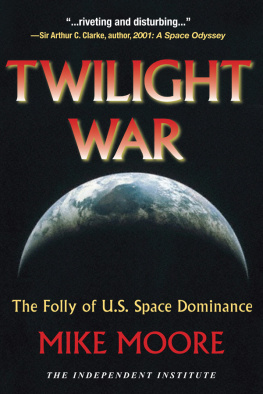Laser Weapons in Space
Westview Replica Editions
The concept of Westview Replica Editions is a response to the continuing crisis in academic and informational publishing. Library budgets for books have been severely curtailed. Ever larger portions of general library budgets are being diverted from the purchase of books and used for data banks, computers, micromedia, and other methods of information retrieval. Interlibrary loan structures further reduce the edition sizes required to satisfy the needs of the scholarly community. Economic pressures on the university presses and the few private scholarly publishing companies have severely limited the capacity of the industry to properly serve the academic and research communities. As a result, many manuscripts dealing with important subjects, often representing the highest level of scholarship, are no longer economically viable publishing projects--or, if accepted for publication, are typically subject to lead times ranging from one to three years.
Westview Replica Editions are our practical solution to the problem. We accept a manuscript in camera ready form, typed according to our specifications, and move it immediately into the production process. As always, the selection criteria include the importance of the subject, the work's contribution to scholarship, and its insight, originality of thought, and excellence of exposition. The responsibility for editing and proofreading lies with the author or sponsoring institution. We prepare chapter headings and display pages, file for copyright, and obtain Library of Congress Cataloging in Publication Data. A detailed manual contains simple instructions for preparing the final typescript, and our editorial staff is always available to answer questions.
The end result is a book printed on acid-free paper and bound in sturdy library-quality soft covers. We manufacture these books ourselves using equipment that does not require a lengthy make-ready process and that allows us to publish first editions of 300 to 600 copies and to reprint even smaller quantities as needed. Thus, we can produce Replica Editions quickly and can keep even very specialized books in print as long as there is a demand for them.
About the Book and Editor
Laser Weapons in Space: Policy and Doctrine
edited by Keith B. Payne
This is the first comprehensive examination of the issues surrounding the potential development by the United States of a space-based laser weapons program. The authors assess the implications of arms control agreements for a satellite-based laser program, including discussions of recent Soviet space-related arms control initiatives and the forthcoming ABM treaty review. They outline likely Soviet responses to a U.S. space-based laser system, address criticisms of the proposed program, and consider its future in light of developments in U.S. defense strategy and doctrine.
Keith B. Payne is vice-president and director of national security studies at the National Institute for Public Policy and author of Nuclear Deterrence in U.S. -Soviet Relations (Westview, 1982) .
Laser Weapons in Space
Policy and Doctrine
edited by Keith B. Payne
First published 1983 by Westview Press
Published 2018 by Routledge
52 Vanderbilt Avenue, New York, NY 10017
2 Park Square, Milton Park, Abingdon, Oxon OX14 4RN
Routledge is an imprint of the Taylor & Francis Group, an informa business
Copyright 1983 by Taylor & Francis
All rights reserved. No part of this book may be reprinted or reproduced or utilised in any form or by any electronic, mechanical,or other means, now known or hereafter invented, including photocopying and recording, or in any information storage or retrieval system,without permission in writing from the publishers.
Notice:
Product or corporate names may be trademarks or registered trademarks, and are used only for identification and explanation without intent to infringe.
Library of Congress Cataloging in Publication Data
Main entry under title:
Laser weapons in space.
(A Westview replica edition)
Includes bibliographical references.
1. Space warfare--Addresses, essays, lectures.
2. Lasers--Military applications--Addresses, essays,
lectures. 3. Arms control--Addresses, essays,
lectures. I. Payne, Keith B.
UG1530.L37 1983 358'.8 82-20045
ISBN 13; 978-0-367-02019-4(hbk)
I would like to thank Dan Strode of the National Institute for Public Policy for his contributions to this book. In addition, I would like to thank Candace Smoot, Beth Miller and Sue Munn for their invaluable and patient assistance in the preparation of the manuscript.
Keith B. Payne
1
Introduction and Overview of Policy Issues
Keith B. Payne
This book addresses the policy issues associated with space-based lasers as a means of ballistic missile defense (BMD). It is not a technical feasibility study, and no attempt has been made to calculate either the absolute or the opportunity costs of space-based lasers. However, the following chapter by Dr. Patrick Priel, does provide a technical overview of space-based BMD. The focus of the book is on a different order of question: how well or poorly would such a system (assuming it could be built and built effectively) serve the national interest? More specifically, the implications of space-based lasers for arms control, U.S.-Soviet relations, deterrence, and nuclear strategy, are examined in detail.
In this chapter it is argued that space-based lasers would enhance, not undermine, crisis stability. Space-based lasers could be used to improve the survivability of U.S. strategic forces, promoting deterrence. It is the assured survivability of a retaliatory force, not the vulnerability of our own society, which is the key to deterrence stability. It is argued that by promoting deterrence, space-based lasers would accomplish one of the primary objectives of arms control -- reduce the probability of war. While deployment of a space-based BMD system would involve either renegotiation or withdrawal from the ABM Treaty, the strategic rationale for continued U.S. support of that agreement is not unassailable. The failure to achieve an adequate arms control agreement on offensive arms which would ensure the survival of land-based ICBMs, has removed much of the rationale for continued acceptance of the Treaty.
In the third chapter, "Implications of Arms Control Agreements for Space-Based Laser BMD," Alan Jones analyzes those provisions of the 1972 ABM Treaty and other international agreements which impinge on the development, testing, and deployment of space-based lasers. Dr. Jones argues that the ABM Treaty is the only extant agreement that would affect a decision to pursue this type of technology. However, the Treaty permits "substantial partial testing of components for space-based BMD lasers while prohibiting full-system testing and deployment of such systems."
In , "Space-Based Lasers ror Ballistic Missile Defense: Soviet Policy Options," Rebecca Strode examines possible Soviet military responses to U.S. space-based laser BMD, the role of missile defense in Soviet strategy, and the manner in which the U.S.S.R. has responded to technological challenges in the past. Ms. Strode concludes that there is little chance that the Soviet Union would respond to deployment of a U.S. space-based laser with a direct attack. Instead, the Soviets would use political means to drive a wedge between Western Europe and the United States, arguing that American actions were responsible for "the death of arms control." Ms. Strode also analyzes a number of technical responses, including comparable BMD deployments and possible increases in offensive systems. While the Soviets would probably wish to combine a number of potential responses, economic constraints may force greater reliance on one option in the long run. Ms. Strode speculates that this option would probably be BMD.













